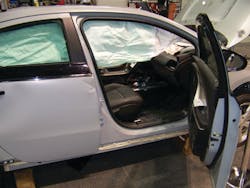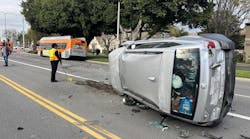SUBJECT: Electric Vehicles
TOPIC: Part 4 — Chevrolet VOLT Extrication Procedures
OBJECTIVE: Given a crash scenario involving a 2011 Chevrolet VOLT with occupant injury and/or entrapment, the emergency responder will understand and be capable of accomplishing vehicle rescue and extrication tasks as appropriate.
TASK: Using an acquired junk vehicle for training, the rescue team shall study the information provided and practice extrication techniques as if the vehicle involved were a Chevrolet VOLT with simulated occupants inside.
In Part 4 of our series on the Chevrolet VOLT, we review vehicle rescue and extrication tasks and provide an understanding of how some of our rescue work may have to be modified because of the design and safety features of this vehicle. The list of rescue tasks begins with vehicle stabilization and includes glass removal, jammed door opening and removal, and B-pillar removal. The images presented here are of the actual VOLT vehicle on which this author demonstrated extrication techniques during the 2010 Fire Rescue International conference in Chicago, IL.
Stabilization of the VOLT is no different than what is currently done with any other passenger vehicle. The best practice for vehicle stabilization when a VOLT is found on four wheels on a level surface requires "chock, block and blow" activities. When only patient packaging is necessary and the vehicle is in pretty good shape, the VOLT should have at least one tire chocked and blocking placed beneath the undercarriage on the patient's side of the vehicle. If extrication tools are to be committed to the car, then chock a tire, block underneath both A-pillars and C-pillars, and then deflate all tires.
The window and windshield safety glass on the VOLT is typical of most passenger vehicles, featuring tempered side and rear windows and a laminated windshield.
Besides a truly remarkable and crash-worthy structural design, the VOLT comes equipped with eight supplemental restraint airbags. The driver and passenger frontal airbags are two stage. Driver and front passenger knee bag restraints are present low along the instrument panel as well.
Both front seats are outfitted with side-impact seat-mounted torso airbags. Occupant head protection comes from the roof-mounted airbag on each side of the car. Like all roof airbags, patient access will be obstructed when the roof airbag has deployed. A deployed roof airbag will be somewhat firm when you arrive at the scene. It can be cut away by responder personnel using a rescue knife or scissors.
There is one stored gas inflator for each roof airbag and it is located along the inside of the C-pillar, near the point where the hydraulic lifter for the hatchback is mounted. A word of caution when stripping the trim to locate these roof airbag inflators: The familiar cylinder-shaped metal inflator is completely concealed within a nylon cloth cover. After stripping the inside C-pillar trim piece away, rescue personnel will have to make an extra effort to actually feel by hand until they are able to locate the inflator because it is wrapped in this cloth material.
Despite the fact that approximately 80% of the steel in the VOLT is high-strength, the door hinges and latch mechanisms are just what we have been used to for many years. Prying a jammed door open and breaking a door off at the hinges or cutting the door off at the hinges can be done using any tool and technique that you currently employ on other passenger vehicles.
Moving or removing the B-pillar involves working with some of the toughest, most crash resistant steel on the VOLT. The B-pillar is constructed of Martensite steel, which is one of the newest advanced steels used in vehicles today. In addition, the entire rocker panel is advanced steel as well. Reciprocating saws and air chisels are not able to cut into or through Martensite steel. Unless your power rescue tool cutter is a new-generation cutter, rated and capable of cutting advanced steel, your hydraulic rescue equipment might be out-gunned by the strength of this steel as well. Make sure you and your team are familiar with the advanced-steel "work-around" techniques presented in the September 2009 University of Extrication column. You will need this knowledge to deal with an entrapment situation when you find yourself unable to cut the B-pillar.
TASK: Using an acquired junk vehicle for training, the rescue team shall study the information provided and practice extrication techniques as if the vehicle involved were a Chevrolet VOLT with injured and/or trapped occupants inside.
Read the rest of the series here:
RON MOORE, a Firehouse® contributing editor, is training chief for the McKinney, TX, Fire Department. He also authors a monthly online article in the Firehouse.com "MembersZone" and serves as the Forum Moderator for the extrication section of the Firehouse.com website. Moore can be contacted directly at [email protected].






